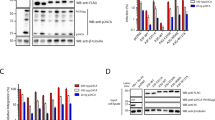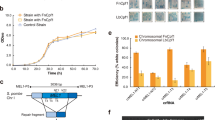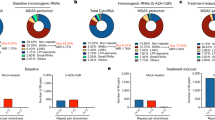Abstract
Endogenous retroviruses are multicopy retroelements accounting for nearly 10% of murine or human genomes1,2. These retroelements spread into our ancestral genome millions of years ago and have acted as a driving force for genome evolution2,3,4. Endogenous retroviruses may also be deleterious for their host, and have been implicated in cancers and autoimmune diseases5. Most retroelements have lost replication competence because of the accumulation of inactivating mutations, but several, including some murine intracisternal A-particle (IAP) and MusD sequences, are still mobile6,7. These elements encode a reverse transcriptase activity and move by retrotransposition, an intracellular copy-and-paste process involving an RNA intermediate. The host has developed mechanisms to silence their expression, mainly cosuppression and gene methylation4,8. Here we identify another level of antiviral control, mediated by APOBEC3G, a member of the cytidine deaminase family that was previously shown to block HIV replication9,10,11,12. We show that APOBEC3G markedly inhibits retrotransposition of IAP and MusD elements, and induces G-to-A hypermutations in their DNA copies. APOBEC3G, by editing viral genetic material, provides an ancestral wide cellular defence against endogenous and exogenous invaders.
This is a preview of subscription content, access via your institution
Access options
Subscribe to this journal
Receive 51 print issues and online access
$199.00 per year
only $3.90 per issue
Buy this article
- Purchase on Springer Link
- Instant access to full article PDF
Prices may be subject to local taxes which are calculated during checkout




Similar content being viewed by others
References
Boeke, J. D. & Stoye, J. in Retroviruses (eds Coffin, J. M., Hugues, S. H. & Varmus, H. E.) 343–436 (Cold Spring Harbor Laboratory Press, Cold Spring Harbor, New York, 1997)
Bannert, N. & Kurth, R. Retroelements and the human genome: New perspectives on an old relation. Proc. Natl Acad. Sci. USA 101(suppl. 2), 14572–14579 (2004)
Johnson, W. E. & Coffin, J. M. Constructing primate phylogenies from ancient retrovirus sequences. Proc. Natl Acad. Sci. USA 96, 10254–10260 (1999)
Kazazian, H. H. Jr. Mobile elements: drivers of genome evolution. Science 303, 1626–1632 (2004)
Lower, R. The pathogenic potential of endogenous retroviruses: facts and fantasies. Trends Microbiol. 7, 350–356 (1999)
Dewannieux, M., Dupressoir, A., Harper, F., Pierron, G. & Heidmann, T. Identification of autonomous IAP LTR retrotransposons mobile in mammalian cells. Nature Genet. 36, 534–539 (2004)
Ribet, D., Dewannieux, M. & Heidmann, T. An active murine transposon family pair: retrotransposition of ‘master’ MusD copies and ETn trans-mobilization. Genome Res. 14, 2261–2267 (2004)
Bourc'his, D. & Bestor, T. H. Meiotic catastrophe and retrotransposon reactivation in male germ cells lacking Dnmt3L. Nature 431, 96–99 (2004)
Sheehy, A. M., Gaddis, N. C., Choi, J. D. & Malim, M. H. Isolation of a human gene that inhibits HIV-1 infection and is suppressed by the viral Vif protein. Nature 418, 646–650 (2002)
Mangeat, B. et al. Broad antiretroviral defence by human APOBEC3G through lethal editing of nascent reverse transcripts. Nature 424, 99–103 (2003)
Harris, R. S. et al. DNA deamination mediates innate immunity to retroviral infection. Cell 113, 803–809 (2003)
Mariani, R. et al. Species-specific exclusion of APOBEC3G from HIV-1 virions by Vif. Cell 114, 21–31 (2003)
Heidmann, O. & Heidmann, T. Retrotransposition of a mouse IAP sequence tagged with an indicator gene. Cell 64, 159–170 (1991)
Dupressoir, A. & Heidmann, T. Germ line-specific expression of intracisternal A-particle retrotransposons in transgenic mice. Mol. Cell. Biol. 16, 4495–4503 (1996)
Baust, C. et al. Structure and expression of mobile ETnII retroelements and their coding-competent MusD relatives in the mouse. J. Virol. 77, 11448–11458 (2003)
Jarmuz, A. et al. An anthropoid-specific locus of orphan C to U RNA-editing enzymes on chromosome 22. Genomics 79, 285–296 (2002)
Wedekind, J. E., Dance, G. S., Sowden, M. P. & Smith, H. C. Messenger RNA editing in mammals: new members of the APOBEC family seeking roles in the family business. Trends Genet. 19, 207–216 (2003)
Lecossier, D., Bouchonnet, F., Clavel, F. & Hance, A. J. Hypermutation of HIV-1 DNA in the absence of the Vif protein. Science 300, 1112 (2003)
Suspene, R. et al. APOBEC3G is a single-stranded DNA cytidine deaminase and functions independently of HIV reverse transcriptase. Nucleic Acids Res. 32, 2421–2429 (2004)
Yu, Q. et al. Single-strand specificity of APOBEC3G accounts for minus-strand deamination of the HIV genome. Nature Struct. Mol. Biol. 11, 435–442 (2004)
Wiegand, H. L., Doehle, B. P., Bogerd, H. P. & Cullen, B. R. A second human antiretroviral factor, APOBEC3F, is suppressed by the HIV-1 and HIV-2 Vif proteins. EMBO J. 23, 2451–2458 (2004)
Bishop, K. N., Holmes, R. K., Sheehy, A. M. & Malim, M. H. APOBEC-mediated editing of viral RNA. Science 305, 645 (2004)
Marin, M., Rose, K. M., Kozak, S. L. & Kabat, D. HIV-1 Vif protein binds the editing enzyme APOBEC3G and induces its degradation. Nature Med. 9, 1398–1403 (2003)
Stopak, K., de Noronha, C., Yonemoto, W. & Greene, W. C. HIV-1 Vif blocks the antiviral activity of APOBEC3G by impairing both its translation and intracellular stability. Mol. Cell 12, 591–601 (2003)
Sawyer, S. L., Emerman, M. & Malik, H. S. Ancient adaptive evolution of the primate antiviral DNA-editing enzyme APOBEC3G. PLoS Biol. 2, E275 (2004)
Moran, J. V. et al. High frequency retrotransposition in cultured mammalian cells. Cell 87, 917–927 (1996)
Goodier, J. L., Ostertag, E. M., Du, K. & Kazazian, H. H. Jr. A novel active L1 retrotransposon subfamily in the mouse. Genome Res. 11, 1677–1685 (2001)
Liddament, M. T., Brown, W. L., Schumacher, A. J. & Harris, R. S. APOBEC3F properties and hypermutation preferences indicate activity against HIV-1 in vivo. Curr. Biol. 14, 1385–1391 (2004)
Turelli, P., Vianin, S. & Trono, D. The innate antiretroviral factor APOBEC3G does not affect human LINE-1 retrotransposition in a cell culture assay. J. Biol. Chem. 279, 43371–43373 (2004)
Esnault, C., Casella, J. F. & Heidmann, T. A Tetrahymena thermophila ribozyme-based indicator gene to detect transposition of marked retroelements in mammalian cells. Nucleic Acids Res. 30, e49 (2002)
Acknowledgements
We thank S. Wain-Hobson for useful comments, N. Landau and the NIH AIDS reagents program for the gift of reagents. This work was supported by grants from the Institut Pasteur, the Institut Gustave Roussy, the ANRS, Sidaction, the Ligue Nationale contre le Cancer, the CNRS, INSERM and the European Community. F.D. is a fellow of Sidaction. Some relevant original papers have not been cited owing to space constraints.
Author information
Authors and Affiliations
Corresponding authors
Ethics declarations
Competing interests
The authors declare that they have no competing financial interests.
Supplementary information
Supplementary Figure S1
IAP and MusD base mutation spectra induced by APOBEC3G in the cell-based retrotransposition assay. (PPT 89 kb)
Supplementary Figure S2
Distibution of G-to-A hypermutations in MusD sequences found in the mouse genome. (PPT 134 kb)
Supplementary Figure Legends
This file contains legends to Supplementary Figures. (DOC 23 kb)
Rights and permissions
About this article
Cite this article
Esnault, C., Heidmann, O., Delebecque, F. et al. APOBEC3G cytidine deaminase inhibits retrotransposition of endogenous retroviruses. Nature 433, 430–433 (2005). https://doi.org/10.1038/nature03238
Received:
Accepted:
Issue Date:
DOI: https://doi.org/10.1038/nature03238
This article is cited by
-
The interferon stimulated gene-encoded protein HELZ2 inhibits human LINE-1 retrotransposition and LINE-1 RNA-mediated type I interferon induction
Nature Communications (2023)
-
The coevolution between APOBEC3 and retrotransposons in primates
Mobile DNA (2022)
-
Addressing the benefits of inhibiting APOBEC3-dependent mutagenesis in cancer
Nature Genetics (2022)
-
RNA editing in the forefront of epitranscriptomics and human health
Journal of Translational Medicine (2019)
-
Origins and evolutionary consequences of ancient endogenous retroviruses
Nature Reviews Microbiology (2019)
Comments
By submitting a comment you agree to abide by our Terms and Community Guidelines. If you find something abusive or that does not comply with our terms or guidelines please flag it as inappropriate.



